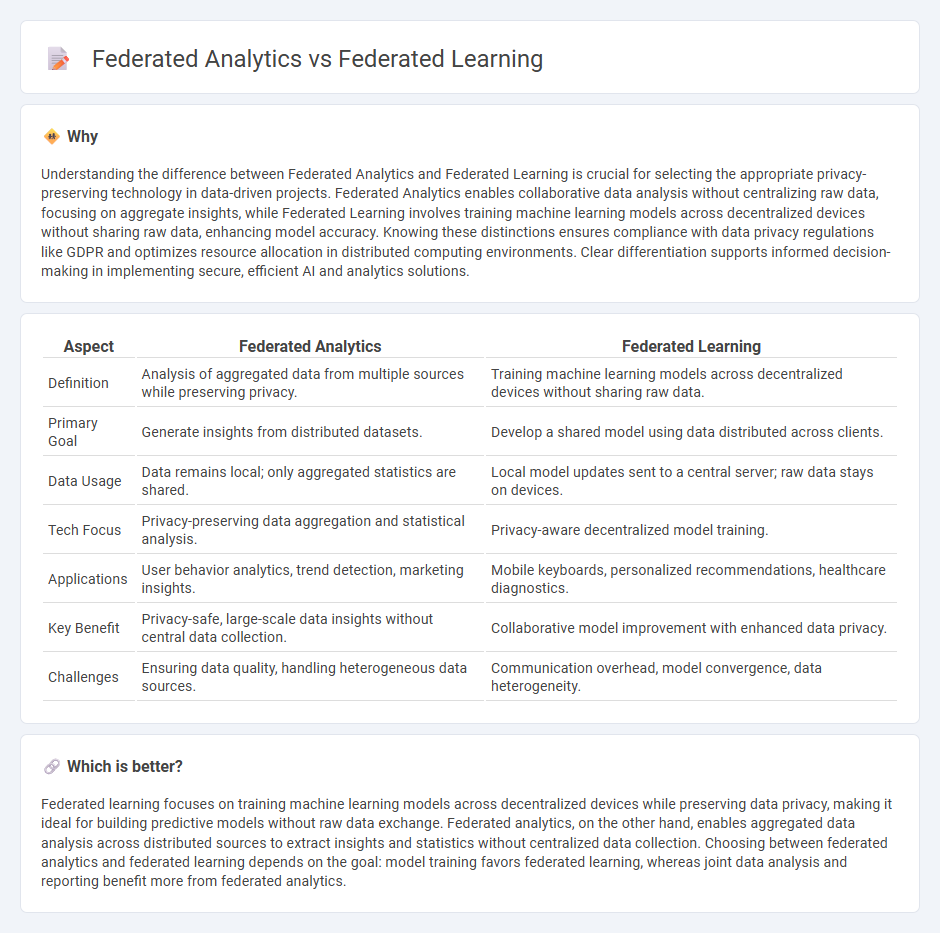
Federated analytics enables data analysis across decentralized sources without sharing raw data, preserving privacy while extracting valuable insights. Federated learning focuses on training machine learning models collaboratively across multiple devices or servers, enhancing accuracy without centralizing sensitive information. Explore the key differences and applications of federated analytics and federated learning to understand their impact on secure data utilization.
Why it is important
Understanding the difference between Federated Analytics and Federated Learning is crucial for selecting the appropriate privacy-preserving technology in data-driven projects. Federated Analytics enables collaborative data analysis without centralizing raw data, focusing on aggregate insights, while Federated Learning involves training machine learning models across decentralized devices without sharing raw data, enhancing model accuracy. Knowing these distinctions ensures compliance with data privacy regulations like GDPR and optimizes resource allocation in distributed computing environments. Clear differentiation supports informed decision-making in implementing secure, efficient AI and analytics solutions.
Comparison Table
| Aspect | Federated Analytics | Federated Learning |
|---|---|---|
| Definition | Analysis of aggregated data from multiple sources while preserving privacy. | Training machine learning models across decentralized devices without sharing raw data. |
| Primary Goal | Generate insights from distributed datasets. | Develop a shared model using data distributed across clients. |
| Data Usage | Data remains local; only aggregated statistics are shared. | Local model updates sent to a central server; raw data stays on devices. |
| Tech Focus | Privacy-preserving data aggregation and statistical analysis. | Privacy-aware decentralized model training. |
| Applications | User behavior analytics, trend detection, marketing insights. | Mobile keyboards, personalized recommendations, healthcare diagnostics. |
| Key Benefit | Privacy-safe, large-scale data insights without central data collection. | Collaborative model improvement with enhanced data privacy. |
| Challenges | Ensuring data quality, handling heterogeneous data sources. | Communication overhead, model convergence, data heterogeneity. |
Which is better?
Federated learning focuses on training machine learning models across decentralized devices while preserving data privacy, making it ideal for building predictive models without raw data exchange. Federated analytics, on the other hand, enables aggregated data analysis across distributed sources to extract insights and statistics without centralized data collection. Choosing between federated analytics and federated learning depends on the goal: model training favors federated learning, whereas joint data analysis and reporting benefit more from federated analytics.
Connection
Federated learning enables decentralized model training by aggregating insights from multiple edge devices without sharing raw data, preserving privacy and enhancing security. Federated analytics extends this concept by performing collective data analysis across distributed sources, allowing organizations to extract meaningful patterns and statistics while maintaining data confidentiality. Both approaches leverage decentralized computation and secure aggregation techniques, making them integral components of privacy-preserving technologies in the AI and data science landscape.
Key Terms
Data Privacy
Federated learning enables decentralized model training by allowing devices to collaboratively learn without sharing raw data, thus enhancing data privacy and security. Federated analytics, on the other hand, performs data analysis across distributed datasets while keeping data localized, minimizing risks of exposure or breach. Explore how both approaches balance privacy with utility in modern data ecosystems.
Decentralized Computation
Federated learning enables decentralized computation by training machine learning models directly on edge devices, preserving data privacy and reducing the need for centralized data storage. Federated analytics, on the other hand, focuses on aggregating statistical insights from distributed data without moving raw data to a central server, optimizing privacy and efficiency in data analysis. Explore the differences in decentralized architectures and their applications to understand how each approach enhances privacy-preserving data computation.
Model Training vs. Data Analysis
Federated learning enables decentralized model training by allowing multiple devices to collaboratively update a shared machine learning model without sharing raw data, enhancing privacy and efficiency. In contrast, federated analytics focuses on aggregating and analyzing data insights from distributed sources without centralizing raw data, supporting data-driven decisions while maintaining user confidentiality. Explore more to understand how these approaches transform distributed AI and data privacy.
Source and External Links
What Is Federated Learning? - IBM - Federated learning is a decentralized machine learning approach where individual nodes (like devices or servers) train a global model using their local data, and a central server aggregates these updates to improve the overall model without exposing sensitive data.
What is federated learning? - IBM Research - In federated learning, multiple parties collaboratively train a shared AI model by downloading it, updating it with their private data, and sending only model updates--not raw data--back to a central server for aggregation and refinement.
Federated learning - Wikipedia - Federated learning trains machine learning algorithms across multiple local datasets (on separate client devices) by exchanging model parameters rather than data samples, enabling collaborative model improvement while preserving data privacy and accommodating heterogeneous data distributions.
 dowidth.com
dowidth.com